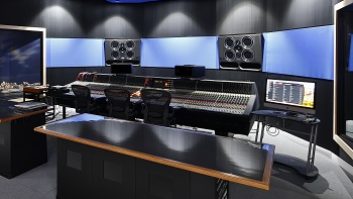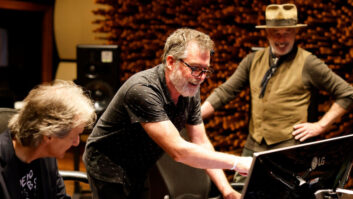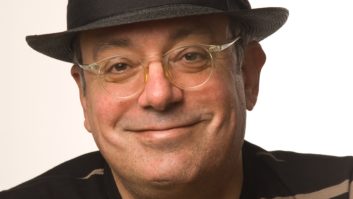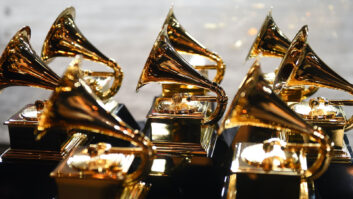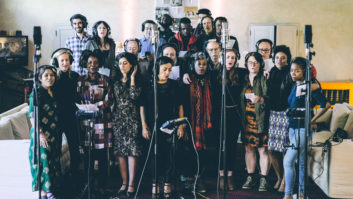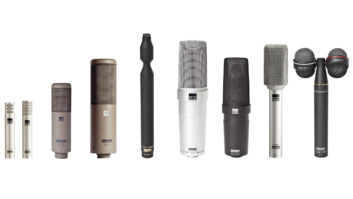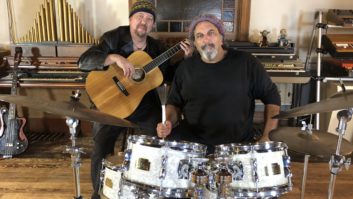Producer/bassist/songwriter Larry Klein has had a broad and successful musical career, yet he feels as though he’s constantly working to avoid being typecast. As a first-call jazz bassist in the ’70s, he worked with such icons as Freddie Hubbard, Carmen McRae and an up-and-coming singer named Dianne Reeves. But Klein grew tired of constant touring and mainstream jazz’s restrictions. Eventually, he started drifting into the pop world and again thrived as a player.
But when listening to his work on records and CDs, he often became frustrated, feeling that they were sometimes bad sonic representations of himself. This led him to involving himself much more in studio matters, and it wasn’t long before he made the transition to working as a producer, where he could exert the kind of sonic control he wanted. His first major project was ex-Cars bassist Benjamin Orr’s The Lace, with Mike Shipley engineering. It was cut in Bath, England, in 1985, and released the following year. Around the same time, he played on Peter Gabriel’s much-heralded So and produced his then-wife Joni Mitchell’s CD Dog Eat Dog.
He and Mitchell have continued to collaborate since then, completing a total of eight projects thus far. However, as a couple, they broke up in 1994, in the midst of the sessions for Mitchell’s 1995 Grammy Award-winning Turbulent Indigo. The success of that album led to a steady stream of female singer/songwriters coming to Klein to produce. He’s helmed projects by notable artists, including Shawn Colvin, Bonnie Raitt, Mary Black and Julia Fordham. All of these were projects Klein wanted to do, but he feared he was now being typecast as the “female singer/songwriter guy,” while he wanted to produce in many genres.
Analytical, inquisitive and restless, Klein is always on the prowl for new challenges in music and in the studio. These days, his approach and attitude is fairly Zen-like, with producing, playing and songwriting/arranging in perfect balance. Each satisfies different creative urges.
What qualities in your personality make it easy for you to work with female singer/songwriters?
I think there’s something about my manner that’s kind of steered toward working with them. Possibly because I’m a little less defensive and protective about the creative process than some other men might be. I think it’s a big asset when working on records with women to be able to provide a climate in the studio where it’s supportive. As a generality, female artists are more delicate in that sense. So that the endeavor is thought of as a joint venture that’s exciting and creative, rather than, “Okay, this is how it’s going to be. You’re going to listen to what I have to say,” which is the auteur kind of approach.
You’re a producer, bassist and songwriter/arranger. What do think of yourself as foremost?
I love the sculptural and creative process of making a record. That probably is my favorite thing to do, but at the same time, I love playing bass. And I’m still excited by playing for other people, especially artists I really respect and enjoy working with.
Because you’re not known as a big hit-making, blockbuster producer, what’s your objective when you’re working with an artist?
It never has been [my objective to make a blockbuster hit]. My philosophy is that I’m always trying to, A) help the artist I’m working with make the best record that they can possibly make; B) make something that I’m going to be proud of, and that I’m going to be able to listen to on the radio or anywhere else, and not have to hide my head; and C) stretch the sensibilities of the artist that I’m working with to a way of conceiving music that’s going to push them forward. Basically, I try to open them up to new territory in their own talent.
I’m also aware of the pragmatic concerns of singles and having something that can get on the radio. But it really is more important to me to make something that holds up on an artistic level, because the business area, such as sales and airplay, hinge on so many fickle and unpredictable elements.
The relationship you have with Joni Mitchell is very provocative and highly personal. What would you say you’ve learned from it?
Through the records I’ve worked on with her, I think she kind of groomed me. I had to be slapped around a little bit, in respect to certain ways I dealt with her toward the beginning of our creative collaborations. I had to acquire a sense of syntax, how to say things that aren’t critical, demeaning and dismissive. Also, knowing when to say something is such an important thing in the creative process. You have to stay aware of the spirit in a room and not hammer down someone’s enthusiasm when it’s in a delicate state. Also, realizing that there’s an element of mystery and serendipity involved with making records; it’s not always a rational and linear process. All these things she helped a lot with me learning, and some of them I had to learn the hard way.
What are you currently doing with Joni?
I’m preparing all the music for a two-record set of her songs that we’re recontextualizing for orchestra. It’s sort of a retrospective examination of her works, through up to her now 18th record. It’ll be looking back through all this work she’s done with orchestra and 10 different instrumental groups. The goal is to make people more aware of the compositional innovations she’s done through her career. It’ll be a lot of music, 24 songs. We’ll be tracking it in London with the orchestra and finish it in the studio here [Santa Monica, Calif.], adding Wayne Shorter as the featured soloist. I’ll also be working with Vince Mendoza. He’s a very talented orchestrator/arranger and composer in his own right, and we’ve teamed up for about four other projects previously.
What’s the craziest Joni Mitchell story you tell can me without her getting mad?
She’s always had a serendipitous, mystical sense of timing, which has always astounded me. There was one incident where we were working on a song we’d written together for a record of hers. At a certain point, she wanted to go down the street to this American Indian antique convention at the Santa Monica Civic Auditorium. I said, “Oh no, you can’t go down there. You’ll be there for hours and we’re on the clock here.” Then all of sudden, BOOM! Lightning struck somewhere around the studio and the power went out. So everything had to be reset, and there were some problems with the console. So she said, “Okay, I’m going down to the Indian event.”
I started dreading that she would be there for hours, but almost about the same time that we got everything up and running, she returned. With her was an Indian movie actor, Iron Eyes Cody, who had been in all these John Wayne movies and other westerns. So we ended up incorporating him chanting over this song [“Lakota,” from Chalkmark in a Rain Storm], which ended up working out really well. But it was this chain of weird, synchronystic, serendipitous events that led to her coming back with this Indian chief.
Was it difficult to make the transition from playing jazz to rock and pop?
No, because I’ve always been very eclectic in the music that I played and was a fan of. I always loved country music, was in rock bands from the time I was in sixth grade, and I was always interested in pop and rock music. I was part of the generation of musicians that was equally interested in pop music and jazz. So it wasn’t that big a switch for me.
Do you feel you have a particular style of producing?
I would say that I try to approach things from an individual standpoint. From project to project, I try as much as I can to break the palette of colors that I’m using. Essentially, I’m trying to do new things that can even involve using a different engineer or a whole new situation. For instance, on these Joni records I’m working on, I’ll be using a guy named Jeff Foster to track the orchestra in England. He’s just an amazing orchestral engineer and does a lot of work at AIR Lyndhurst over there. Then I’ll be using my engineer that I work with most of time — Helix Hadar — for overdubs, and I’ll be mixing the record with Alan Thymes over at Ocean Way. I try to change the methodology of what I’m doing as much as I can from record to record.
Who are some of your influences as a producer and as a musician?
There are so many people I’ve learned a lot from. In the pop world, it’s Mutt Lange — he’s a tremendously talented guy, and I learned quite a bit from him. I worked on Lindsey Buckingham’s album Out of the Cradle, and I was quite impressed with his sense of adventure as a producer/artist. Also, I certainly respect Daniel Lanios as a producer.
As a musician, my heroes are Wayne Shorter and Miles Davis, who have always been looking to stretch the boundaries. That’s what I have a real passion for.
You’re also working on a solo project.
It’s my own music and it’s electronic-based. One of the songs is built around samples of a Claus Ogerman orchestral piece that I was religiously in love with when I was 17 years old. That kind of thing is fantastically exciting to me, to take the genre of electronica and introduce the sophistication of jazz, without making it sound like an unnatural hybrid.
What did you hear in Julia Fordham’s songs that were different from her past work?
She played some of them that she already had written, and they almost felt like “soul” songs. They had a tempered R&B thing about them, which was a new element I hadn’t heard in her music before. So I presented that to her and explained how I was thinking of putting her CD together. Some of it would be programmed with the drums and even some of the bass, but also braided with organic aspects. I wanted the clarity that a programmed drum provides, but then having blood on top. So, from the beginning, I was emphatic about using Billy Preston and felt that he would be an important element to make it a “blue-soul” kind of thing, which she really loved.
Do you have a special approach to song-writing?
The compositional process of writing within the context of making a record is really a vital and important part of what my dynamic with artists is. Raymond Carver, the short-story writer, said the best time to write something is right after you finish something. Because there’s no pressure and you’re not trying to write something.
It’s always different with every artist. Some need something to force them to get in motion. That was the case with Shawn Colvin; when we started, she only had four songs written. We wrote a couple together, and she took a break to finish writing. With Julia, she had more songs than we needed. So we ended up deciding which songs to set aside. We wrote one [“Roadside Angel”] together that ended up on the record.
Even though you’re always trying to have a fresh approach to projects, are there any tried-and-true methods you employ?
Yeah, I do. Especially with technical aspects and an aesthetic sense in regard to sonic considerations. I always like the bottom end to have a really full roundness that tape provides. I just like the way bass sounds off tape. And there are certain microphones that you just love the way they sound. And that holds true for different devices and boxes that you use for similar situations you encounter from project to project.
What are some of the mics you really like?
It depends on the singer and the project, but there are a lot of different ones I really like. I got an AKG C-12 that I love. The mic we’re using on Joni for this record is an old Telefunken 251; it’s a beautiful-sounding mic. There’s also the Neumann 149, a new version of the old M49 tube mic, that I use on a lot of things.
Do you consider yourself a hands-on person when it comes to engineering?
Ideally, I’d like to not have to deal with that end of things. I function better when I can just think about the musical aspects of projects. I do like to experiment and fiddle around with different plug-ins to stay abreast of what the possibilities are. There are so many that are coming out for Pro Tools that are fantastic, and quite a few of them I’ve been using like crazy.
Is it essential for you to play on a recording that you produce?
It depends on what the situation is. There are times when it’s very liberating to not have to be playing, because you can be sitting, listening and thinking about things during a take. You can already be considering what changes need to be made. Whereas, obviously if you’re playing, you’ve got to take the time [after] to sit back and listen. You can do both, but sometimes it’s quicker to just be listening. But I have to say I tend to play quite a bit on things that I produce.
Who have you learned the most from since you started producing?
I think I’ve learned more from the artists that I’ve worked with than from other producers. I have to say more than anyone else Joni — she taught me a lot about producing. She’s sort of my philosophical/production mentor.
Chris Walker is a contributor to Mix.
